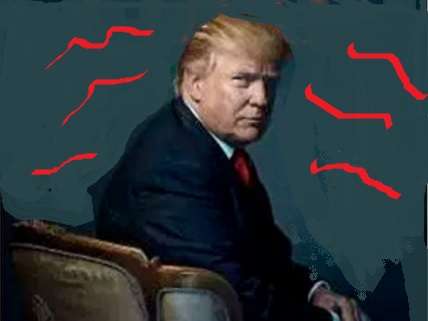Trump's Budget Plan: The Good, the Bad, and The Ugly
It doesn't cut overall spending, it's based on gimmicks, but it does slash some programs.
As Ronald Bailey notes, Donald Trump's first full budget plan is based on what Ronald Reagan's budget director David Stockman denounced as "rosy scenarios." Trump's budget rests upon an assumption of 3 percent annual growth, which is in stark contrast to the 1.4 percent average growth between 2008 and 2016.
As important and despite headlines talking about the massive spending cuts embodied in Trump's plan, his budget increases spending:

When you look at the overall numbers (above), spending increases to $4.1 trillion in 2018 and rises to $5.7 trillion in 2027. So much for reductions. When figured as a percentage of the economy (GDP), we see a slow decline from 20.5 percent next year down to 18.4 percent in 2027, but those figures are screwy because they're based on the phoney-baloney growth projections. The same goes for receipts, whether estimated in dollars or percentages. Only in the fantasyland of government accounting can a budget that projects spending $900 billion more in 2027 than 2018 be described as "Trump seeks to slash $3.6 trillion in austere budget."

If Trump's rosy growth projections are bad and his year-over-year increases in spending are ugly, what's good about his budget? The president is calling for the elimination of no fewer than 66 programs, including four in the Department of Agriculture that will spend nearly a billion dollars, another four in Commerce that cost $633 billion, and almost $5 billion worth in Education. Similarly, he is calling for rolling back food-assistance programs whose ranks swelled during the recession but have stayed high despite low unemployment rates. While many of these sorts of cuts won't be realized at all, it's always worth pushing the idea that government programs shouldn't always become permanent fixtures.
In this sense, Trump's budget encapsulates his promise and peril as president. He is devoid of clearly articulated principles and there are many reasons to expect him to do real damage to the economy and the country. At the same time, he also may well augur the end of the slow car wreck that represents consensus politics in the post-World War II era. The United States is running out of other people's money and we need to start the hard work of figuring out a sustainable level of government that we can both pay for and thrive under. In some of his deregulatory gestures, Trump points in that direction, and he has clearly shown himself willing and able to push hard against the status quo.
If we're lucky, he is the last 20th-century president and will set the table for a much-needed, much-delayed way of doing politics for the 21st century.


Show Comments (23)